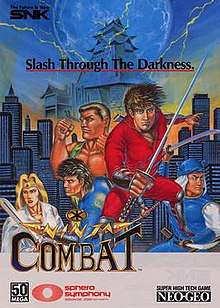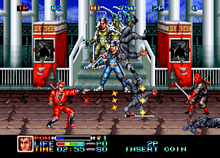Ninja Combat
Ninja Combat[lower-alpha 1] is a 1990 side-scrolling beat 'em up video game developed by Alpha Denshi and published by SNK. It was one of the launch titles for both the Neo Geo MVS (arcade) and AES (home) systems.[1] It is notorious for its unbalanced difficulty and odd design and gameplay ideas.
| Ninja Combat | |
|---|---|
 European Arcade flyer | |
| Developer(s) | Alpha Denshi |
| Publisher(s) |
|
| Producer(s) | Tsutomu Maruyama |
| Designer(s) | Hatsue Honbe Kazushige Hakamata Shinji Moriyama |
| Programmer(s) | Eiji Fukatsu Hideo Kamoda Teruaki Shirasawa |
| Artist(s) | Mitsunari Ishida Kenichi Sakanishi |
| Composer(s) | Hideki Yamamoto Hiroaki Shimizu |
| Platform(s) | |
| Release | 1990
|
| Genre(s) | Beat 'em up, hack and slash |
| Mode(s) | |
| Cabinet | Upright |
| Arcade system | Neo Geo MVS |
Gameplay

The journey takes the ninja heroes from an amusement park to the top of a tower. Along the way, they must survive endless attacks from the members of Kage Ichizoku and their minions. The protagonists Joe and Hayabusa use shuriken as their primary weapon, although other weapons that aid them along the way are nunchaku, maces, ratchets, battle axes, spiked clubs, and katana swords. A special somersault attack can be used to knock down a multiple enemies in a row. As an art of ninpo kairou, a fire dragon can be summoned to destroy all enemies on the screen.[2]
Plot
The story, set in the year "199X", follows the twin ninja warriors named Joe (ジョー) and Hayabusa (ハヤブサ, lit. "Falcon") (not to be mistaken with Joe Musashi or Ryu Hayabusa), who are waging a battle against an evil ninja clan Kage Ichizoku (影一族, lit. "Shadow Family"). Their mission is to fight their way into the enemy home fortress, the Ninja Tower (ニンジャタワー, "Ninjatawa"), which has emerged from the ocean in the center of New York City, to once and for all defeat the Shadow Family and its leader, the long thought-dead demon sorcerer Genyousai. When defeated, three of the minibosses: Musashi (ムサシ), Kagerow (カゲロウ, lit. "Mayfly") and Gembu (ゲンブ), become allies and fight alongside Joe and Hayabusa as optional player characters. If the heroes are victorious, Genyousai is destroyed and the Ninja Tower crumbles.
Release
Ninja Combat was originally released in Japanese arcades on July 24, 1990. Its home version was released internationally for the Neo Geo in 1991 and for the Neo Geo CD on October 31, 1994 in Japan only.[3] The original soundtrack for both Ninja Combat and The Super Spy, along with the arranged versions by SNK Sound Team and KONNY, was published by Pony Canyon and Scitron on November 21, 1990.[4]
Ninja Combat was re-released through Nintendo's Virtual Console download service in Europe and Australia on October 26, 2007, and in North America on June 2, 2008. It is also one of the five games ported to the PlayStation 2 in the game compilation ADK Damashii in 2008.
Reception
| Contemporary reception | ||||||||||||||||||||||||||||||||||
|---|---|---|---|---|---|---|---|---|---|---|---|---|---|---|---|---|---|---|---|---|---|---|---|---|---|---|---|---|---|---|---|---|---|---|
| ||||||||||||||||||||||||||||||||||
In Japan, Game Machine listed Ninja Combat on their December 15, 1990 issue as being the eighteenth most-successful table arcade unit of the year, outperforming titles such as Shanghai II.[19] The game was received with mixed reception from critics.[20] Famicom Tsūshin scored the Neo Geo version a 22/40.[11]
Retrospective reviews
| Retrospective assessments | ||||||||||
|---|---|---|---|---|---|---|---|---|---|---|
| ||||||||||
The Virtual Console release received the score of only 3.5/10 from Lucas M. Thomas of IGN, who called it "a profoundly unappealing gameplay experience," opining that "anything potentially innovative or interesting about Ninja Combat gets totally defeated by its terribly stiff control and overly difficult programming."[22]
See also
- Gang Wars
- Ninja Commando
References
- "Oh! Neo Geo Vol. 1 - ニンジャコンバット". Beep! MegaDrive (in Japanese). No. 36. SoftBank Creative. September 1992. p. 140.
- Ninja Combat user's manual (Neo Geo AES, US)
- "Neo•Geo CD: The Arcade In A Box - Ninja Combat". GamePro. No. Premiere Supplement. IDG. Spring 1996. p. 106.
- "PCCB-00046 | The Super Spy / Ninja Combat". VGMdb. Retrieved 2013-12-22.
- "Ninja Combat for NeoGeo". GameRankings. CBS Interactive. 2019. Retrieved 2019-06-26.
- Dillon, Tony (December 1990). "Screentest - Console - Ninja Combat: SNK pit you against arcade quality opponents". ACE. No. 39. EMAP. p. 103.
- Knight, Kyle (1998). "Ninja Combat (Neo Geo Advanced Entertainment System) - Review". AllGame. All Media Network. Archived from the original on 2014-11-15. Retrieved 2019-06-26.
- Rignall, Julian (November 1990). "Complete Guide to Consoles - The Complete Games Guide - Neo Geo - Ninja Combat". Computer and Video Games Mean Machines. No. 4. EMAP. pp. 86–88.
- "Ninja Combat (Neo Geo): I ninja sono una strana razza: enigmatici, silenziosi e capaci di sparire sempre in ogni momento lasciando una nuvola di fumo blu". Consolemania (in Italian). No. 1. Xenia Edizioni. October 1991. p. 42.
- Harris, Steve; Semrad, Ed; Alessi, Martin; Williams, Ken (March 1991). "Review Crew - Neo Geo - Ninja Combat". Electronic Gaming Monthly. No. 20. Sendai Publishing. p. 22.
- "NEO GEO GAMES CROSS REVIEW: ニンジャコンバット". Famitsu (in Japanese). No. 332. ASCII. 28 April 1995. p. 22.
- "Neo Geo For Real! - Previously Played... - Ninja Combat". GamePro. No. 30. IDG. January 1992. p. 103.
- "Tests - Neo Geo - Ninja Combat". Joystick (in French). No. 8. Anuman Interactive. September 1990. p. 91.
- "Console News - Neo Geo: Ninja Combat". Joystick (in French). No. Hors-Serie 3. Anuman Interactive. July–August 1991. p. 60.CS1 maint: date format (link)
- Noak, Philipp; Hellert, Stefan (August 1993). "Special - Neo Geo - Ninja Combat". Mega Fun (in German). No. 11. CT Computec Verlag GmbH & Co. KG. pp. 28–30. Archived from the original on 2018-10-21. Retrieved 2019-06-26.
- Yanma; Itabashi (July 1992). "Super Soft 大特集 - 今、『NEO・GEO』がおもしろい!: ニンジャコンバット". Micom BASIC Magazine (in Japanese). No. 121. The Dempa Shimbunsha Corporation. p. 208.
- Boardman, Julian (October 1991). "Reviews - Ninja Combat (Neo Geo)". Raze. No. 12. Newsfield. p. 60.
- Pascual, Alberto (October 1992). "Consola - En pantalla: Ninja Combat - El espíritu de las artes marciales (Neo-Geo: arcade)". Superjuegos (in Spanish). No. 6. Grupo Zeta. pp. 68–69.
- "Game Machine's Best Hit Games 25 - テーブル型TVゲーム機 (Table Videos)". Game Machine (in Japanese). No. 394. Amusement Press, Inc. 15 December 1990. p. 25.
- Drevet, Cyril; Scamps, Olivier (December 1990). "Stop Info - La Neo-Geo De S.N.K. -- Ninja Combat". Player One (in French). No. 4. Média Système Édition. pp. 14–16.
- Whitehead, Dan (June 17, 2008). "Virtual Console Roundup • Page 2 - Fatal Fury 2, Ninja Combat, Last Ninja 2, Nebulus, Alex Kidd in Miracle World". Eurogamer. Gamer Network Ltd. Retrieved 2019-04-26.
- M. Thomas, Lucas (June 18, 2008). "Ninja Combat Review". IGN. Ziff Davis. Retrieved 2019-04-26.
- McFerran, Damien (June 2, 2008). "Ninja Combat Review (Neo Geo)". Nintendo Life. Nlife Media. Retrieved 2019-04-26.